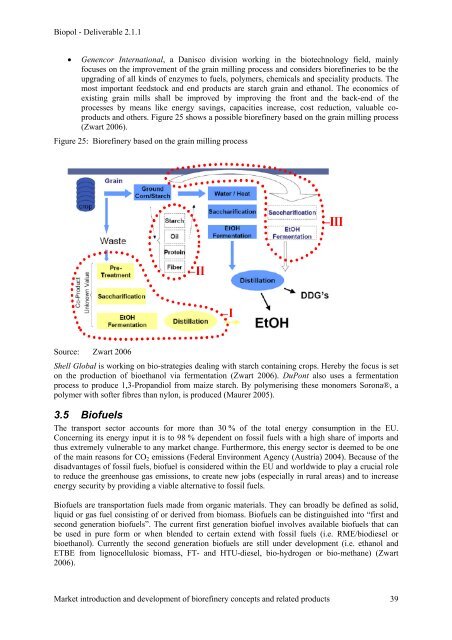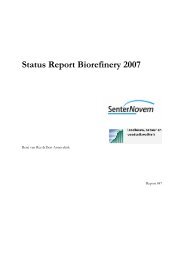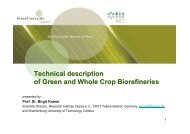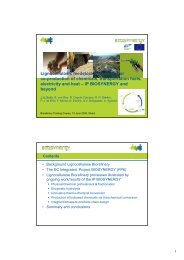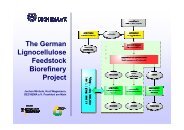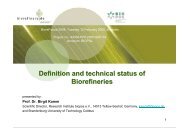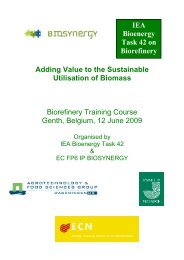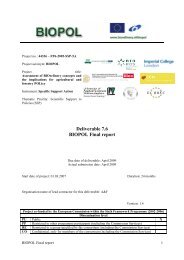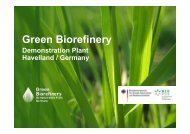D 2.1.1 Note on literature review concerning market ... - Biorefinery
D 2.1.1 Note on literature review concerning market ... - Biorefinery
D 2.1.1 Note on literature review concerning market ... - Biorefinery
You also want an ePaper? Increase the reach of your titles
YUMPU automatically turns print PDFs into web optimized ePapers that Google loves.
Biopol - Deliverable <str<strong>on</strong>g>2.1.1</str<strong>on</strong>g><br />
• Genencor Internati<strong>on</strong>al, a Danisco divisi<strong>on</strong> working in the biotechnology field, mainly<br />
focuses <strong>on</strong> the improvement of the grain milling process and c<strong>on</strong>siders biorefineries to be the<br />
upgrading of all kinds of enzymes to fuels, polymers, chemicals and speciality products. The<br />
most important feedstock and end products are starch grain and ethanol. The ec<strong>on</strong>omics of<br />
existing grain mills shall be improved by improving the fr<strong>on</strong>t and the back-end of the<br />
processes by means like energy savings, capacities increase, cost reducti<strong>on</strong>, valuable coproducts<br />
and others. Figure 25 shows a possible biorefinery based <strong>on</strong> the grain milling process<br />
(Zwart 2006).<br />
Figure 25: <strong>Biorefinery</strong> based <strong>on</strong> the grain milling process<br />
Source: Zwart 2006<br />
Shell Global is working <strong>on</strong> bio-strategies dealing with starch c<strong>on</strong>taining crops. Hereby the focus is set<br />
<strong>on</strong> the producti<strong>on</strong> of bioethanol via fermentati<strong>on</strong> (Zwart 2006). DuP<strong>on</strong>t also uses a fermentati<strong>on</strong><br />
process to produce 1,3-Propandiol from maize starch. By polymerising these m<strong>on</strong>omers Sor<strong>on</strong>a®, a<br />
polymer with softer fibres than nyl<strong>on</strong>, is produced (Maurer 2005).<br />
3.5 Biofuels<br />
The transport sector accounts for more than 30 % of the total energy c<strong>on</strong>sumpti<strong>on</strong> in the EU.<br />
C<strong>on</strong>cerning its energy input it is to 98 % dependent <strong>on</strong> fossil fuels with a high share of imports and<br />
thus extremely vulnerable to any <strong>market</strong> change. Furthermore, this energy sector is deemed to be <strong>on</strong>e<br />
of the main reas<strong>on</strong>s for CO2 emissi<strong>on</strong>s (Federal Envir<strong>on</strong>ment Agency (Austria) 2004). Because of the<br />
disadvantages of fossil fuels, biofuel is c<strong>on</strong>sidered within the EU and worldwide to play a crucial role<br />
to reduce the greenhouse gas emissi<strong>on</strong>s, to create new jobs (especially in rural areas) and to increase<br />
energy security by providing a viable alternative to fossil fuels.<br />
Biofuels are transportati<strong>on</strong> fuels made from organic materials. They can broadly be defined as solid,<br />
liquid or gas fuel c<strong>on</strong>sisting of or derived from biomass. Biofuels can be distinguished into “first and<br />
sec<strong>on</strong>d generati<strong>on</strong> biofuels”. The current first generati<strong>on</strong> biofuel involves available biofuels that can<br />
be used in pure form or when blended to certain extend with fossil fuels (i.e. RME/biodiesel or<br />
bioethanol). Currently the sec<strong>on</strong>d generati<strong>on</strong> biofuels are still under development (i.e. ethanol and<br />
ETBE from lignocellulosic biomass, FT- and HTU-diesel, bio-hydrogen or bio-methane) (Zwart<br />
2006).<br />
Market introducti<strong>on</strong> and development of biorefinery c<strong>on</strong>cepts and related products<br />
39


